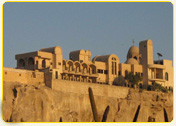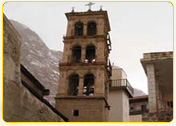Christian - St. Catherine's Monastery
Located at the foot of Mount Moses, St. Catherine’s Monastery, was constructed by order of the Emperor Justinian between 527 and 565. It is built around what is thought to be Moses’ Burning Bush, which has a chapel built atop it. It is a spectacular natural setting for priceless works of art, including Arab mosaics, Greek and Russian icons, Western oil paintings, paintings on wax, fine sacerdotal ornaments, marbles, enamels, chalices, reliquaries, including one donated by Czar Alexander II in the 19th century, and another by Empress Catherine of Russia in the 17th century.
But of perhaps even greater significance is that it is one of the largest and most important collection of illuminated manuscripts in the world (The Vatican has the largest). The collection consists of some 4,500 volumes in Greek, Coptic, Arabic, Armenian, Hebrew, Slavic, Syriac, Georgian and other languages.
St. Catherine’s has a rich history indeed. So rich that it is a sparkling example of an undiscovered jewel of travel. It has been called the oldest working Christian monastery and the smallest diocese in the world. The Chapel of the Burning Bush was originally ordered built by Empress Helen, the mother of Constantine the Great, but the monastery itself was actually built by Emperor Justinian to protect the monks in the region and to honor the site of the Burning Bush. St. Catherine, whose body was reportedly carried away by angels, was discovered five hundred years later at the top of the peak that now bears her name. Her relics are stored in a marble reliquary in the Basilica. We have additional pictures of this church, and of its interior.
St. Catherine’s is also a formidable fortification, with granite walls measuring 8 to 35 meters tall, surrounded by gardens and cypresses. Prior to probably the twentieth century, the only entrance to St. Catherine’s was a small door 30 feet high, where provisions and people were lifted with a system of pulleys, and where food was often lowered to nomads. It has withstood numerous attacks over its 14 hundred year existence, thus protecting a rich store of art. Today, while it is one of the oldest monasteries in the world, its original, preserved state is unmatched.
Though patronized during much of its history by the Russian Orthodox Church, it is now under the auspices of the Greek Orthodox Church. Most of its monks are also of Greek origin, though their ranks include an international flavor.


